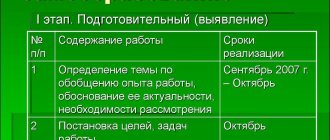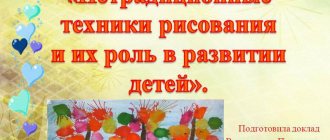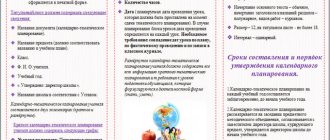Preview:
Consultation “How to write calendar plans according to the Federal State Educational Standard”
“How to write calendar plans according to the Federal State Educational Standard for Education?”
The Federal State Educational Standard for Preschool Education (FSES DO) requires that the content of the educational program of preschool education cover “structural units representing certain areas of development and education of children” (educational areas). The Educational Standard identifies five educational areas:
Social and communicative development is aimed at:
– assimilation of norms and values accepted in society;
– communication and interaction of the child with adults and peers;
– development of intelligence, responsiveness, empathy;
– formation of a respectful attitude and a sense of belonging to one’s family, as well as to children and adults in the Organization (OU);
– formation of positive attitudes towards various types of work and creativity; formation of the foundations of safe behavior in everyday life, society, and nature.
Cognitive development involves:
– development of children’s interests, curiosity and cognitive motivation;
– formation of cognitive actions, formation of consciousness;
– development of imagination and creative activity;
– formation of primary ideas about oneself, other people and objects of the surrounding world;
– formation of ideas about the properties of the surrounding world (shape, color, size, material, sound, rhythm, tempo, quantity, number, part and whole, space and time, movement and rest, causes and effects, etc.);
– formation of ideas about the small homeland and Fatherland, about cultural values, about traditions and holidays, about planet Earth, about the diversity of countries and peoples of the world.
Speech development includes:
– mastery of speech as a means of communication and culture;
– enrichment of the active dictionary;
– development of coherent dialogic and monologue speech;
– acquaintance with book culture, children’s literature;
– formation of sound analysis as a prerequisite for learning to read and write.
Artistic and aesthetic development presupposes:
– understanding of works of art (verbal, musical, visual);
– the formation of an aesthetic attitude towards the surrounding world;
– ideas about types of art;
– perception of music, fiction, folklore;
– implementation of independent creative activities of children (visual, constructive-model, musical).
Physical development includes:
– formation of initial ideas about some sports;
– mastering outdoor games with rules;
– formation of healthy lifestyle values.
The indicated educational areas (EO) can be implemented in various types of activities (communication, games, cognitive and research activities).
For preschool children (3 years - 7 years old) relevant activities:
– gaming (role-playing games, games with rules, other types of games);
– communicative (communication and interaction with adults and peers);
– entertaining and research (studies of environmental objects and experiments with them);
– artistic and aesthetic (perception of artistic literature and folklore);
– labor activity (self-service, basic household work);
– constructive-model activity (construction from different materials);
– visual, productive (application, modeling, drawing);
– musical (perception of a piece of music, singing, musical-rhythmic movements, playing children’s musical instruments);
– motor (mastery of basic movements, forms of child activity).
Scheduling is prepared in accordance with the above (according to the Standard). You can use block planning, or use continuous text. How convenient.
We choose the theme of the week in accordance with age, the theme changes every week (for example, for the 2nd junior group - “professions”, “Spring is red”, Healthy”, “Plants of our group”, “Furniture”, “Book week” " etc.).
We prescribe educational areas and types of activities according to the Federal State Educational Standard, as well as forms of work, methods and techniques. For example,
Approximate scheduling
for younger preschool age (3-4 years) per day
2nd week of September (from 09/07/15 to 09/11/15), topic “Vegetables and fruits”
1. Didactic game “Vegetables and Fruits”, goal: to learn to name familiar vegetables and fruits, to be able to group objects by color, size, shape (select all red, all large, all round objects), enrich the vocabulary with new words;
2. D/i “Find the odd one out”, goal: to consolidate the ability to recognize and distinguish between vegetables and fruits; fix colors: red, yellow, green; development of fine motor skills of the hands.
adding a basket with dummies of fruits and vegetables to the group
– pronouncing speech material, commenting on actions.
3. P/game “We have a vegetable garden”, goal: to teach how to perform game actions in accordance with the text of the game.
Outdoor game with speech accompaniment:
– showing each stage of the game;
– pronouncing speech material, commenting on actions.
4. Board-printed games based on interests (Lego, Mosaic, Domino-fruit), goal: development of fine motor skills, strengthening the ability to recognize fruits.
N/a game “Loto Plants”, goal: to consolidate the names of vegetables and fruits, to be able to distinguish them.
– introduction of a new game “Loto Plants”
– considering a new game;
-questions to children about choosing a game;
Visual activity (modeling on the theme “Turnip”), goal: to arouse children’s interest in creating images based on familiar fairy tales; learn how to sculpt a turnip: create the basic shape by rolling out a ball using circular movements of your palms; develop a sense of form.
– indirect communication through a toy;
– showing and examining an object;
– repeated speaking of speech material
– showing the teacher a sample.
Monitoring the state of the weather, goal: to learn to determine the time of year by characteristic signs.
NGO “Social and communicative development”.
Outdoor game “Sparrows and a car”, goal: to teach children to run quickly according to a signal, without bumping into each other, to act according to the teacher’s signal, orienting themselves, to find their place.
NGO "Physical Development", NGO "Social and Communicative Development"
– repeated pronunciation of signal words.
Individual work with children (1-2 people):
– learning the rhyme “In Yegor’s garden” or “Lariska has two radishes.” Goal: development of attention, memory, formation of emotional and aesthetic perception of the surrounding world;
– d/i with the ball “Call it affectionately” (cucumber-cucumber, etc.)
NGO “Social and communicative development”, NGO “Speech development”, NGO “Physical development”
An outdoor game with speech accompaniment.
Didactic game with a ball.
– learn to use natural materials (sand, water) in games and act with them in a variety of ways.
– Develop the ability to interact and get along with each other in a joint game.
– Give an idea of the properties of sand (dry – crumbles, wet – molds).
Games with external material.
Goal: to encourage children to try to select games on their own.
Source of the article: https://nsportal.ru/detskiy-sad/upravlenie-dou/2016/02/08/kak-pisat-plany-po-fgos
How to write a work program for a kindergarten teacher according to the Federal State Educational Standard
Recommendations for educators on writing a work program.
Author: Gribanova Anna Leonidovna Position and place of work: teacher, MBDOU No. 44 “Combined kindergarten”, Kemerovo. Description of the material: I bring to your attention recommendations for writing, designing and developing a work program. This material may be useful to preschool directors when drawing up regulations on a teacher’s work program, senior educators when writing the main preschool work program, and educators when developing their own programs. Contents of the teacher's work program Currently, global changes are taking place in the preschool education system. They are due to the fact that, in accordance with the Federal Law of December 29, 2012 No. 273-F3 “On Education in the Russian Federation,” the preschool education system has become the first stage of the Russian education system. This led to the adoption of the Federal State Educational Standard for Preschool Education (FSES DO), which determines what the program of a preschool educational institution should be and what conditions are needed for its implementation. The teacher’s work program is developed by the teacher based on the educational program of the preschool educational institution. The structure and content of the work program is developed taking into account the requirements and standards approved at the federal level (in our case, in accordance with the Federal State Educational Standard for Preschool Education, which has been in effect since January 1, 2014). The work program is a normative document and is approved by the head of the preschool institution. One program is sufficient for a group of the same age; it is not advisable for each teacher to write it; co-authors of the program can be: managers, 2 teachers, preschool specialists, and a creative group. Approximate structure of the educational program (laws give us partial freedom in planning the educational process) 1. Title page , which indicates: • Name of the educational institution • By whom and when the program was adopted and approved (protocol numbers and date) ADOPTED by the Pedagogical Council of the MBDOU Protocol No. of 2016 APPROVED Head of MBDOU No. Full name _____________ Order No.___ dated “___”_______2016 • Name of the work program (age of children, school year) • Compilers of the program (full name, position, category) • City and year of development of the program 2. Contents of the program (table of contents) 3. The program itself 1.
Target section 1.1.
Explanatory note (indicating the relevance of the program, goals, objectives, program participants, implementation deadlines) 1.2. Regulatory documents on the basis of which the program was developed • Constitution of the Russian Federation, Art. 43, 72. • Convention on the Rights of the Child (1989). • Federal Law “On Education in the Russian Federation” (2012). • Order of the Ministry of Education and Science of the Russian Federation (Ministry of Education and Science of Russia) dated October 27, 2011 N 2562 Moscow “On approval of the Model Regulations on a preschool educational institution.” • Sanitary and epidemiological requirements for the design, content and organization of the regime of preschool educational institutions. SanPin 2.4.1.3049-13 • Charter of preschool educational institution. • GEF DO. 1.3. Main characteristics of the developmental characteristics of children in this group (Age characteristics) 1.4. List of children indicating date of birth and age as of September 1, 2016 1.5. Psychological and individual characteristics of children in this group (characteristics for the group, not for each child) 1.6. Social passport of the group as of 09/01/2016 (information about parents) 2.
Organization of the regime of children’s stay in an educational institution 2.1.
Organization of the stay of children in preschool educational institutions (for cold and warm periods) 2.2. System of hardening measures 2.3. System of health measures 2.4. Organization of motor mode 2.5. Schedule of organized educational activities (class schedule) 2.6. Cyclogram of educational activities for a week or day (at the request of management) 3.
Content section 3.1.
Long-term thematic planning for the year (you can include “Working with parents” in this section if you don’t have a separate plan) Topic of the week Goal Replenishing the developmental environment 3.2. Educational area “Cognitive development” Calendar and thematic planning for the educational area “Cognitive development” 3.3. Educational area “Speech development” Calendar and thematic planning for the educational area “Speech development” 3.4. Educational field “Artistic and aesthetic development” Calendar and thematic planning for the educational field “Artistic and aesthetic development” 3.5. Educational area “Physical development” Calendar and thematic planning for the educational area “Physical development” 3.6. Educational field "Social and communicative development" Long-term - thematic planning for the educational field "Social and communicative development" 4.
Planned results of mastering the Program This section describes the basic knowledge, abilities and skills, level of development that students must master in the process of implementing a specific educational program areas.
5.
Monitoring system In the monitoring process, the physical, intellectual and personal qualities of the child are examined through observations, conversations, expert assessments, etc. A mandatory requirement for building a monitoring system is a combination of low-formalized (observation, conversation, survey, analysis of activity products, etc.) and highly formalized (tests, etc.) methods ensuring the objectivity and accuracy of the data obtained.
Monitoring of the educational process (Appendix No. 1) Monitoring of the educational process (monitoring of the development of the educational program) is carried out by kindergarten teachers (educators and specialists). It is based on an analysis of children's achievement of intermediate results. Monitoring of child development (Appendix No. 2) Monitoring of child development (monitoring of the development of integrative qualities) is carried out by teachers (caregivers, other specialists) and a medical worker (pediatrician). The main objective of this type of monitoring is to identify the individual developmental characteristics of each child and, if necessary, outline an individual route of educational work to maximize the potential of the child’s personality. 6.
Long-term planning for interaction with parents
4. List of references The list of references indicates all programs, methodological publications and teaching aids used to develop the Work Program and used in the process of its implementation. The list is constructed in alphabetical order, indicating the city and name of the publishing house, the year of publication of the literature. The list of references is drawn up in accordance with GOST 7.1-2003. The list of material and technical equipment includes: Printed manuals. Technical teaching aids and ICT tools. Digital and electronic educational resources. Educational-practical and educational-laboratory equipment. Game and didactic material. Demonstration aids. Musical instruments, etc. 5. Applications are developed depending on the desires and needs of the teacher. This could be: - description of games and exercises; — card files (walks, morning exercises, etc.); — scenarios for group events; — scripts for master classes for teachers and parents; — scenarios of various forms of interaction with parents; — visual media (visual propaganda materials, booklets, memos), etc. Requirements for the design of the educational program are established in the regulations of the preschool educational institution on the development of the work program. Approximate
requirements for the design of work programs: The text is typed in the Wordfor Windows editor in Times New Roman font, font size 14, tables are filled in font size 12, single line spacing, no hyphens in the text, width alignment, paragraph 1.5 cm, margins on all sides 2 cm. The finished program is stitched (bookleted), the pages are numbered. The title page is considered the first and is not subject to numbering, as well as the application sheets. The list of references is built in alphabetical order; it is allowed to design a list of references in the main sections of each educational field. The program is approved annually at the beginning of the school year (before September 1 of the current year) by order of the head of the preschool educational institution (stamped on the title page). The teacher reserves the right to make minor changes to the program as the work progresses. The variable part of the work program is written and bookleted separately and is closely intertwined with the main program only in weekly planning, which is advisable to include in an appendix.
We recommend watching:
Individual program of correctional and developmental work with preschoolers with intellectual disabilities; Club program in kindergarten for children 6-7 years old; Work program of a preschool teacher according to the Federal State Educational Standard. Sections Work program of additional education in preschool educational institutions in ecology
Similar articles:
Work program for the subject “Introduction to Mathematics” for primary preschool age


